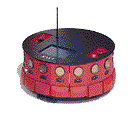 |
The Autonomous Mobile Robot GroupDepartment of Computer ScienceNorthwestern University |
||
Final Projects
|
Remote Robot Control via Everyday DevicesTeam members Andy Crossen Weíve
created three ways to control the robot remotely at your leisure:
through a web controller, with a standard joystick, and using telephony
with any phone through a standard phone line. Our work on telephony control of robot behavior was due to a need for a convenient, ubiquitous control device. Why not be able to control a robot from a device that everyone has, namely, a cellular phone? A combination of Scheme, GRL, Java, and the Microsoft Telephony API provided the necessary tools to build what we were looking for. The robot first detects a userís presence using its front sonars (analogous to asking the question ďIs someone standing in front of me?Ē). Upon noticing someone, a message is sent to a desktop machine with a voice IP modem, which then calls a userís cellular phone. Upon answering the phone, the user now has control over the robot using the keypad on the phone. Pre-programmed behaviors assigned to each number, as well as the # and * keys, are activated on the robot upon pressing the corresponding key.
The web controller provides an alternative interface to the same underlying functionality. Using any forms-capable web client, a user controls the robot through form buttons corresponding to behaviors of the robot. A Java servlet provides the CGI interface to the web controller. The servlet displays a list of behaviors in HTML, and inputs the desired behavior (and robot to perform it on) from the user through an HTML form. The servlet then sends this command to the specified robot through UDP. Having a web client with basic HTML controls allows any device with a simple browser and a network connection to operate a robot. This functionality was tested on a networked desktop machine, a Palm device outfitted with a wireless IP modem, as well as a WinCE device equipped with a wireless network card. The joystick controller works on the same principle. This input device was used to demonstrate directional motor vector commands on the robot with a flight-stick interface. This interface proves the most natural in driving the robot around, a directional vector mapped to each motion of the joystick.
Screenshots from the web controller running on a Compaq iPaq WinCE device General
Device Operation
These
controllers were built within a Java, Scheme, and GRL framework, using the
connectionless UDP protocol for messaging between these languages.
UDP was chosen due its relative ease of implementation on all
platforms, and didnít require a great deal of custom code to be written
to use it. The generic usage
lifecycle of each demonstrated control device is as follows:
Reflections
and Regrets
While
all of our original milestones were met and exceeded, there are some
things we would have done differently, as well as some things we would
have liked to add, given more time.
|
||
|
|
AMRG home |
||


